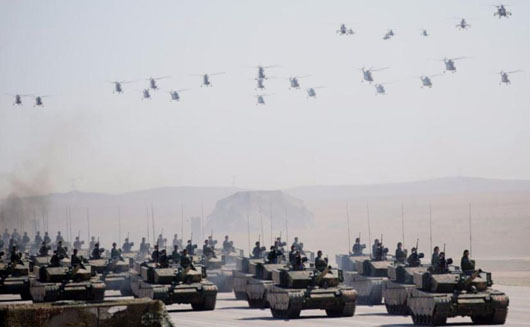by WorldTribune Staff, July 30, 2017
Just hours after being warned by U.S. President Donald Trump over its continued inaction on North Korea, China on July 30 launched a massive military parade that included nuclear-ready H-6K bombers flying overhead and the display of a new nuclear-tipped ballistic missile.
The parade came after a show of force by the United States that included a test of the THAAD missile defense system and the flying of B-1B bombers over the Korean peninsula.

Both China’s parade and the THAAD test followed North Korea’s July 28 test of a ballistic missile that analysts said put the continental U.S. in range of a strike.
President Xi Jinping told Chinese troops they should be ready to defeat all “invading enemies” and that they were “closer to the goal of the great rejuvenation of the Chinese nation.”
Trump on July 29 signaled his disappointment at what he described as China’s inaction on North Korea’s rapidly-advancing nuclear and ballistic missile programs.
“I am very disappointed in China. Our foolish past leaders have allowed them to make hundreds of billions of dollars a year in trade, yet they do NOTHING for us with North Korea, just talk,” Trump wrote in a pair tweets. “We will no longer allow this to continue. China could easily solve this problem!”
On display at the parade were a new Dongfeng-31AG nuclear-tipped ballistic missile and the Dongfeng-21D “aircraft carrier killer.”
Xi has reduced the army’s size by 300,000 but has invested heavily into China’s nuclear arsenal, navy and air force.
“Always listen to and follow the party’s orders,” Xi said at the parade. “And march to wherever the party points to.”
Meanwhile, the U.S. said it shot down a medium-range target ballistic missile in its latest test of THAAD missile defense program.
The Missile Defense Agency (MDA) said the THAAD system has now successfully intercepted test targets 15 times, though the latest test involved a medium-range missile, and not the long-range kind being tested out of North Korea.
“In addition to successfully intercepting the target, the data collected will allow MDA to enhance the THAAD weapon system, our modeling and simulation capabilities, and our ability to stay ahead of the evolving threat,” said MDA Director Lt. Gen. Sam Greaves in a statement.
The U.S. on July 30 flew two supersonic B-1B bombers over the Korean peninsula in a show of force after Pyongyang’s ICBM test, the U.S. and South Korean Air Forces said in a statement.
The bombers took off from a U.S. air base in Guam, and were joined by Japanese and South Korean fighter jets during the exercise, according to the statement.
“North Korea remains the most urgent threat to regional stability,” Pacific Air Forces commander Gen. Terrence J. O’Shaughnessy said in the statement.
“If called upon, we are ready to respond with rapid, lethal, and overwhelming force at a time and place of our choosing.”
Following the North’s mot recent ICBM test, U.S. Secretary of State Rex Tillerson urged world leaders to tighten United Nations sanctions on North Korea and singled out Russia and China for not doing enough to contain Pyongyang’s nuclear ambitions.
“As the principal economic enablers of North Korea’s nuclear-weapon and ballistic-missile development program, China and Russia bear unique and special responsibility for this growing threat to regional and global stability,” he said.
Subscribe to Geostrategy-Direct __________ Support Free Press Foundation
